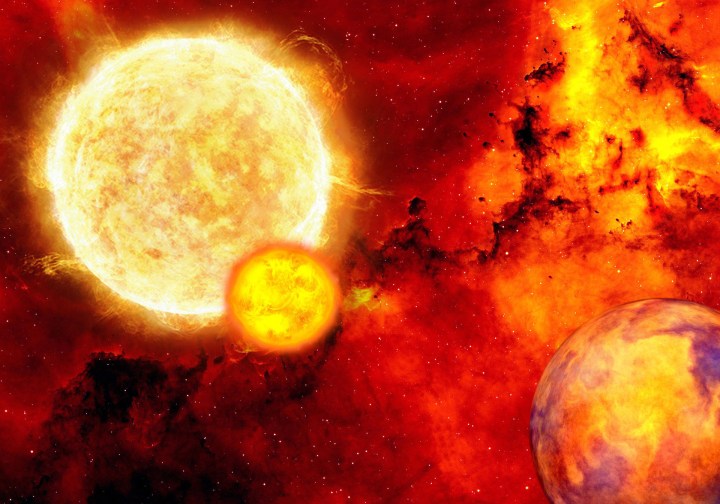EXTREME SCIENCE
The nuclear fusion breakthrough – false hope or tantalising solution to climate catastrophe?

The dream of unlimited energy and power is as old as humanity. Does the first reality of nuclear fusion mean that dream is coming to fruition?
It is a thought as old as human existence. It is as old as the first time a sentient being looked up at the sky and realised the great glowing thing in the sky above was what gave the Earth its warmth and light throughout the day. How could they capture some of it? And, could they find something like it right here on Earth for themselves?
Speculations such as those have triggered humanity’s myths and legends — as well as its scientific explorations.
In one of his most lyrical short stories, The Golden Apples of the Sun, Ray Bradbury, the renowned 20th-century speculative fiction author, described a rocket expedition from Earth whose mission was to skim right across the surface of the sun to scoop up a cargo of the sun’s actual material — the very hydrogen being fused into helium and releasing all that energy.
If successful, humankind would then hold the secret of the nearly unlimited energy released from fusing those atoms.
Just as the spaceship nears its destination of the solar surface, Bradbury sets out the thinking of the ship’s commander, writing:
“[A] million years ago a naked man on a lonely northern trail saw lightning strike a tree. And while his clan fled, with bare hands he plucked a limb of fire, broiling the flesh of his fingers, to carry it, running in triumph, shielding it from the rain with his body, to his cave, where he shrieked out a laugh and tossed it full on a mound of leaves and gave his people summer. And the tribe crept at last, trembling, near the fire, and they put out their flinching hands and felt the new season in their cave, this small yellow spot of changing weather, and they, too, at last, nervously, smiled. And the gift of fire was theirs.”
The title of Bradbury’s story, of course, reaches back to a tale in ancient Greek mythology. One of the 12 labours of Herakles was to purloin — or steal — some very special golden apples. The trees and their apples had been a wedding gift from the goddess Gaia to the gods, Hera and Zeus.
The trees were guarded by the Hesperides, the daughters of the goddess of the night, and the apples were precious precisely because consuming them promised immortality. Even more, consuming them would mean never again experiencing hunger, thirst, suffering or illness.
In more contemporary terms, we might call that access to unlimited energy. It takes only a little imagination to connect those golden apples to the sun and its impact on our planet.
Prometheus unbound
A second Greek legend — the story of Prometheus — gives a second approach to this idea about access to energy. Prometheus, one of the race of Titans, had defied the edicts of the gods and bestowed upon the humanity he had created out of clay the gift of fire. Perhaps he hoped to stir things up a bit in the stodgy Greek pantheon? But, having done these things, the gods determined that as punishment, Prometheus would be chained to a mountaintop and have an enormous carnivorous bird peck at his liver in perpetuity. Ouch. Energy has costs.
As a small child, this writer was transfixed by a giant painting of Prometheus’ punishment by Flemish painter Peter Paul Rubens. It hangs in one of the vast galleries of the Philadelphia Museum of Art — the building atop a riverside hill, whose steps became universally famous because of Rocky Balboa’s ascent of them, as he trained for his boxing matches in each of the Rocky films.
The Prometheus story has been celebrated in western culture for centuries. Economic historian David Landes, in his magisterial history of the industrial revolution, The Unbound Prometheus, used the image of a liberated Prometheus as the metaphor for the cascade of overlapping scientific, technological, economic and societal revolutions that began in Britain and eventually affected nearly the entire planet.
Solved by imagination
Scientists in the 19th century were puzzled about the ultimate source of the sun’s heat and light energy. In the absence of any real understanding of the forces and mechanisms that operate at the atomic level, astronomers and physicists tried to calculate along the line of the processes they understood and concluded it was a nearly insolvable problem.
Based on the size of the sun and the rate of energy it was apparently generating, by any known chemical process, the sun would have consumed itself and been reduced to an inert cinder in just a few thousand years in generating all that output. That was obviously wrong.
It was only in the 20th century, through the imagination and efforts of physicists and mathematicians, when the inner structures of the atom and the mechanism by which hydrogen atoms (actually hydrogen’s deuterium isotope with that important extra neutron) were forced to combine into producing helium-plus-the-release-of-energy were finally worked out. Such understandings came together with observational astronomy to provide a richer understanding about the structure of the universe as well.
Secular Holy Grail
Collectively, these understandings led to both military and peaceful outcomes. They led to the development of the atomic bomb (of which chief scientist J Robert Oppenheimer had said after seeing its first test, “I have become death, destroyer of worlds”, quoting an ancient Hindu text).
But there were also nuclear medicines and commercial nuclear reactors. And then, by the early 1950s, there were thermonuclear weapons that used an atomic weapon core to trigger a violently and enormously explosive fusion reaction of deuterium.
But the secular Holy Grail — creation of a controllable, usable fusion reaction that can generate vast amounts of effectively non-polluting energy whose raw material is unlikely to run out for millions of years — is something that has rivalled the mythic properties of those golden apples. The Promethean gift has remained beyond reach.
This has been true, so far, despite the expenditure of prodigious amounts of money. And it has consumed the working lives of scientists and engineers focused on this seemingly unachievable quest.
More than 30 years ago, it was reported that something called “cold fusion” had been developed. The beauty of this process was that in contrast to what takes place inside the sun, cold fusion could pretty much be done in your kitchen.
Properly developed, people hoped, cold fusion could be a solution to the Earth’s energy needs, effectively without pollution, in contrast to the constraints on energy production of virtually every other source we have now.
However, as the University of California at Berkeley’s website Understanding Science explains:
“Unfortunately, the energy sources currently available to us all have major drawbacks in the long term. Oil is efficient, but contributes to climate change and will run out eventually. Coal is plentiful but polluting. Solar energy is appealing but only as dependable as a sunny day — and it’s currently expensive to boot! [Editorial note: although getting cheaper]
“A clean, reliable energy source that won’t run out any time soon would solve our energy problems and revolutionize the world. You might think such an energy source is a pipe dream, but in fact, it has already been discovered — in seawater!
“Seawater contains an element called deuterium, hydrogen with an extra neutron. When two deuterium atoms are pushed close enough together, they will fuse into a single atom, releasing a lot of energy in the process.
“Unfortunately, figuring out exactly how to get deuterium atoms close enough together — in a way that doesn’t take even more energy than their union generates — has been a challenge.”
A hydrogen atom has only a single proton in its nucleus, whereas deuterium, a rarer isotope of hydrogen, has a proton and a neutron.
The process by which two atoms join together, or fuse, into a single heavier atom is called fusion. Fusion is the energy source of stars, like our sun — where it takes place at at least 100 million degree Celsius.
Visit Daily Maverick’s home page for more news, analysis and investigations
A physicists’ unicorn
In 1989, chemists Stanley Pons and Martin Fleischmann made headlines with claims that they had produced fusion at room temperature — “cold” fusion compared with the high temperatures the process was thought to require. It was the kind of discovery that scientists dream of: a simple experiment with results that could reshape our understanding of physics and change lives the world over.
This “discovery”, however, was missing one key ingredient: good scientific behaviour. And nobody else could ever duplicate their results. As a result, cold fusion has remained a physicists’ unicorn, rather than a reality.
Magic! Alchemy!
Meanwhile, in various laboratories around the world, and especially at the National Ignition Facility of the Lawrence Livermore Laboratory in California, much time, energy and effort has been devoted to creating actual, viable, controlled nuclear fusion reactions that don’t get out of hand like a small thermonuclear weapon. (Scientists have been using minute amounts of potentially fusionable materials, so that is unlikely to be realised.)
Once a fusion reaction is achieved, it has to be a reaction that can be controlled and ramped up to generate prodigious, commercially available energy — energy that can be turned into usable electricity for everyone.
Success in this would be a Prometheus who is more than just unbound, he would be giving the world unlimited energy made from a common material such as seawater that turns into the inert element of helium. Magic! Alchemy!
As a footnote, many people are already well acquainted with the idea of fusion as the energy source of the future from space operas such as Star Wars or Star Trek, where spaceships routinely use fusion reactors.
Being so used to it, however, means we have come to expect it will come along soon enough, just like all the other miraculous technologies that are now part of our everyday lives.
So far, the pathway preferred by many researchers has been to have a tiny globule of hydrogen, held in place by a containment field of extremely powerful magnets, while that fuel is bombarded with energy by powerful laser bursts to force the fusion of hydrogen atoms.
Those results have been less than encouraging, at least if one expects them to have generated more energy than was consumed in generating any energy.
When output exceeds input
The team at the Lawrence Livermore Lab has taken a different route, encasing a blob of frozen hydrogen in a gold-plated spherical diamond, and then bombarding the target with dozens of laser beams.
To their delight, the immediate output of energy was more than the immediate input of energy used for lasers in the experiment, although those calculations do not include all the energy expended in getting this experiment up and running.
In practice, then, the world remains well away from plug-and-play fusion reactors for all occasions and in every neighbourhood.
Still, as the Physics World website was happy to announce:
“Physicists working at a laser-fusion facility in the US have announced a world first – the generation of more energy from a controlled nuclear fusion reaction than was needed to power the reaction.
“They achieved this using the $3.5-billion National Ignition Facility (NIF) – a football-stadium sized system of lasers based at the Lawrence Livermore National Laboratory (LLNL) in California.
“The laser shot, performed on 5 December, released 3.15 million joules (MJ) of energy from a tiny pellet containing two hydrogen isotopes — compared to the 2.05 MJ that those lasers delivered to the target.”
German nuclear physicist Sabine Hossenfelder noted in the New York Times:
“On Dec. 5, 192 lasers at the National Ignition Facility at the Lawrence Livermore National Laboratory in California fired a synchronized shot at a golden cylinder about the size of a jelly bean. With exquisite precision, the capsule focused the laser light on a grain of frozen hydrogen. For a fraction of a second, the temperature in the hydrogen exceeded that in the core of our sun, forcing the nuclei of the hydrogen atoms to merge with each other.”
But, going forward, a real challenge for turning this development into commercially usable technology is that the lasers in use are terribly inefficient. They require about 300 megajoules to fire each shot, energy which is enough to meet the electrical demands of the average American home over three days.
The lasers must become much more efficient, the reaction has to be repeated at a very rapid rate, and the targets themselves will need to be manufactured at low cost in large numbers — and all this needs to happen before the reaction can be seen as even moving towards commercial viability.
Hossenfelder added:
“Given that it will likely be decades until we can power the electricity grid with fusion energy, it is fair to ask whether we should even consider this to be good news for the climate.
“Katharine Hayhoe, a Texas Tech climate scientist, said that it isn’t. ‘We already have the technologies we need to decarbonize 80% of the electricity sector by 2030,’” she tweeted.
“Proving that it’s possible to release energy from fusion in a laboratory will neither meet our immediate need to reduce carbon emissions nor help us control the damage we have already done to the climate. But we have to think beyond our present task of net zero — cutting emissions to as close to zero as possible.”
Still, decisions about what is viable for the future needs a broader canvas of understanding. Hossenfelder continues:
“The decision to ramp up investment into fusion in the wake of this breakthrough is ultimately a question of how much we value the lives of future generations.
“Wind and solar energy often require large installations that take up huge swaths of land (with the exception of offshore wind). Moreover, solar and wind work better in some parts of the world than in others.
“Much of Europe is considerably farther north than the United States and gets less sunlight during the winter. Most of us in Europe also don’t live on an island that we can surround with wind farms.
“Nuclear power — including fusion — is a way to generate a huge amount of power in a small space. That’s a major advantage in a world with already intense pressures on a finite amount of land; future generations deserve a shot at this form of relief.”
There are other issues to be considered in restructuring power sources and grids. Experts note that the American power grid itself is under pressure, with long distance transmission lines in a major need for upgrading and replacement.
Still, the bottom line is that no one should expect that this recent development means the Millennium Falcon will touch down at the nearest airport or that the Starship Enterprise will boldly go anywhere — or that cheap, universally available fusion energy stations that will never run out for millions of years are soon to appear across the landscape — not yet, anyway. But the possibilities are starting to tantalise those with money to invest in new energy. DM




















 Become an Insider
Become an Insider
Contrary to what the author may think, the cities and starships of Star Trek do not make use of fusion reactors as their primary sources of energy ( nor can the technology in Star Wars since anything involving faster-than-light travel would use truly incredible amounts of energy ). Starships in Star Trek do make use of fusion reactors to power their “impulse” engines, but to power their warp drives they make use of matter-antimatter annihilation reactors. The amount of energy generated by fusion reactors is insufficient to generate a warp field which is why matter-antimatter annihilation is used. While talk of impulse and warp engines is just sci-fi technobabble it is a fact of science that matter-antimatter annihilation ( although at this stage we have no idea of how to control such a reaction ) produces massive amounts of energy when compared to fusion reactors. Current scientific theories that discuss warp drive – in actual science it is called the Alcubierre Drive – note that truly enormous amounts of energy would be required to warp space as a warp drive is supposed to do, hence the need for matter-antimatter annihilation.
I have to throw a bit of proverbial cold water on your ideas. According to Albert Einstein’s theory of relativity, upon which all of this technology is based, it is impossible to surpass the speed of light as happens in the movies of Star Trek. So ideas like “warp speed” etc. will stay where it is now – as part of science fiction.